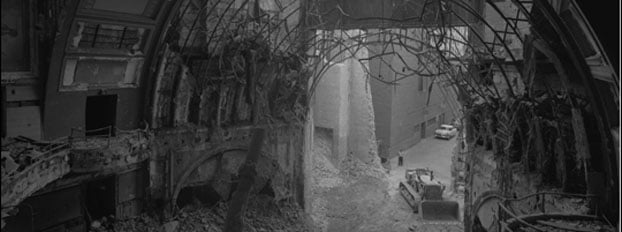
The Richard Nickel Story
"I figure that anyone who tries to save landmarks in Chicago is goofy enough to teach celibacy in a Playboy Club or nonviolence to Dick Butkus."--Mike Royko
Just a few decades ago, Chicago was tearing down its architectural landmarks with a vengeance. Among these were the work of legendary architect Louis Sullivan, and no one, it seemed, felt it was important to document and preserve them. No one, that is, except photographer Richard Nickel. This idealistic crusader's passion to save Chicago's architectural treasures consumed his life and ultimately caused his untimely death.
Richard Nickel had never given architecture any serious thought, or even
heard of Louis Sullivan, before he enrolled in a photography class at the
Institute of Design in Chicago in the early 1950s. There, photography teacher
Aaron Siskind gave Nickel and his classmates a simple assignment: go out
and photograph Sullivan's buildings. It was an assignment that would change
Nickel's life as he became captivated by Sullivan's decorative details.
As he continued to photograph the buildings, he began to devour Sullivan's
writings. In Louis Sullivan, Richard Nickel had found a kindred spirit.
Nickel's brother Donald remembers that Richard was an outsider, even in
his own family. "He read a lot. He'd be up all hours of the night playing
Bach and Mozart, and of course, my folks didn't know Mozart from the man
on the moon." By the time he was 25, Nickel had already been married and
divorced, and had served time in the Army as a paratrooper and photographer.
Now he was living in his parent's attic, which would remain his home until
he died twenty years later.
Nickel began documenting every known Sullivan building. But the buildings
began coming down almost as quickly as he could document them, and it soon
became a race between Nickel and the wreckers. Then it dawned on him: it
was not enough to simply take photographs. He must save as much of the
actual buildings as he could. In 1958, Nickel met two young architecture
students, John Vinci and David Norris, who shared his devotion to Sullivan
and were eager to help him salvage pieces of other buildings. They recall, "He'd
come with his Chevrolet with a bucket in it. . .and a crow bar, a couple
of hammers and coal chisels." He enlisted his brother Donald's help as
well. "I thought he was crazy," Donald says. "You know, I didn't know Sullivan
from Mr. Magoo." Nickel stored the huge pieces of salvaged ornament outside
his parents' home in Park Ridge, despite complaints from the neighbors
about, as Nickel wrote, "the unsightly appearance of the yard."
By 1960, he was exhausted, discouraged, and ready to give up the cause
and get a regular job. But then he learned of plans to demolish Sullivan's
17-story Garrick Theater building to make way for a parking garage. In
all his years of saving ornament, Nickel had never attempted to stop the
wrecking ball and save an entire building.
But the Garrick was one building he could not bear to see torn down. He
fought hard, but in the end the building owners prevailed in court, and
demolition was approved. Losing the Garrick took a great toll on Nickel;
he was mentally and physically drained. But when he heard that Sullivan's
Stock Exchange building was in jeopardy, he entered the fray one last time.
Unable to stop the demolition, Vinci and Nickel were able to save a significant
portion of the building's ornament, including the complete interior of
the Trading Room, which was later recreated at the Art Institute. Even
after the official salvage operation ended, Nickel kept returning to the
site for more pieces. On April 13, 1972, he disappeared. A month later,
after a protracted search, his body was found in the rubble of the building.
He had been crushed when the Trading Room floor collapsed.
Louis Sullivan is now widely viewed as one of the icons of American architecture,
and his lost masterpieces live on in Richard Nickel's photographs and in
the salvaged ornament displayed at the Art Institute of Chicago and around
the world. As for Nickel, history will view him as one of the heroes of
architectural preservation, a man who livedÑand diedÑfor the love of old
buildings.
In 1973, the Art Institute of Chicago presented a one-man exhibition of
100 photographs by Richard Nickel. Curator of Photography David Travis
recalls it as a signal event: "The Ward Gallery was one of our premier
spaces for temporary exhibitions and I believe this was the first time
it was devoted to a single photographer. The museum had not previously
focused such attention on a single photographer and his work."
Richard Nickel Speaking for Himself
Richard Nickel was a prolific and passionate letter writer. Here are
a few quotes:
"I am on earth in [Sullivan's] behalf, and I have only begun to fight."
"What is going on in Chicago?. . .Many smaller insignificant Adler and Sullivan
buildings have gone, but now the Garrick?"
"Great architecture has only two natural enemies: water and stupid men."
"Marvelous being in a work of art under rape. How often do you experience the
bones, veins, skin of a work of art, even if it be in dissection?"
"What a fool I must be. Why am I horsing around, moving the stones from one warehouse
to another, while everybody else is making a dandy living, have their own lives
and apartments and houses, etc.? It's even a problem for me to buy a car."
(reacting to a magazine's praise of the parking garage that replaced
the Garrick)
"They wreck one of [Sullivan's] masterpieces, and you conclude it is a tribute?
Would you say that if someone wrecked St. Peter's Cathedral in Rome and erected
a garage. . .that that was a tribute to St. Peter?"
The Moral of the Story?
Nickel's friend David Norris comments: "I think what Richard had to teach
was that if you find some way to express your deepest convictions, you
should exercise that talent to the very utmost of your ability. . .even
if it leads somehow to your destruction."
On the day after his body was discovered, a Chicago Sun-Times editorial
cartoon honored him with a drawing of a gravestone with the epitaph:
Richard Nickel
1928-1972
Killed in Action
rescuing Chicago architectural treasures
The Chicago Daily News characterized Nickel's death as "a sacrifice
to art--a civic offering on the altar of greed."
Links of Interest
They
All Fall Down: Richard Nickel's Struggle to Save America's Architecture
Richard Cahan's biography of the photographer is profusely illustrated.
Louis
Sullivan: The Architect and His Work
A good source of general information on Sullivan's life and buildings.
Chicago
Landmarks: Architect Louis Sullivan
This City of Chicago site includes a map of Sullivan buildings.
Louis
Sullivan: Prophet of Modern Architecture
Hugh Morrison's authoritative biography of Louis Sullivan.
Louis
Sullivan, 1856-1924
MIT's informational site about its architecture graduates, includes this
page devoted to Sullivan.
GreatBuildings.com:
Louis Sullivan
Links to information on many Sullivan buildings.
Louis
Henri Sullivan Gravestone
This stone at Graceland Cemetery was erected by his admirers using private
contributions.
Telling the Story of Richard Nickel
by program co-producer Margie Newman
Many Chicagoans have heard of Richard Nickel, but too few have seen his
work.
In 1999, I attended an exhibit on architect Louis Sullivan at the City
Museum in St. Louis. Sullivan, who has been called a "prophet of modern
architecture," was a central figure in the Chicago School, an architect
who defined a truly American style and a unique aesthetic vision. But many
of his buildings had been torn down since his death in 1924.
While I was somewhat familiar with Sullivan's work, the powerful photographs
in this exhibit confronted me with the full weight of what had been lost.
A sense of "how could they?" was the overwhelming emotional impact: how
could they obliterate beautiful works of art like these buildings?
Compelled to learn more, I sought out information on both Sullivan and
on Richard Nickel, the photographer whose reverent images of Sullivan buildings
demanded my attention. I was astounded to read Richard Cahan's biography
of Nickel and to learn of this extraordinary man's life and untimely death.
Nickel's story begged to be brought to television, and the story of Chicago's
lost architectural masterpieces is one that every Chicagoan should know.
I am grateful to WTTW for agreeing that this story should be included in
the acclaimed Chicago Stories series, and to co-producer Jay Shefsky for
sharing my enthusiasm for this project.
About the Program Producers
Jay Shefsky, a life-long Chicagoan, has been with WTTW since 1986. His
1999 documentary, "To Live Until I Die," which profiled six remarkable
people as they approached their own deaths, won a CINE Golden Eagle, and
was broadcast nationally on PBS. His 2000 documentary, "A Justice That
Heals," a story of murder and forgiveness in a Chicago suburb, was broadcast
on the ABC News Nightline program. His work has also been awarded
with an Ohio State Award, a Peter Lisagor Award for Broadcast Journalism,
three Emmy Awards, and other honors.
Margie Newman has collaborated with co-producer Jay Shefsky to script three
documentaries in WTTW's Chicago Matters series ("To Live Until
I Die," "A Justice That Heals" and "Teaching Parents"). In addition to
her work at WTTW, Margie produced several episodes of World Museum Classics,
a PBS series featuring special exhibits at museums around the world. She
is a resident of St. Louis.
The Voice of Richard Nickel
In this Chicago Stories documentary, Chicago actor Larry Neumann,
Jr. provides the narrative voice of Richard Nickel, reprising his role
in the recent Lookingglass Theatre production about the photographer.

Your $40 Gift Membership will include:
|
























































